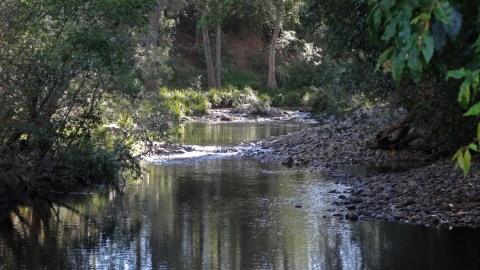- Home
- Assessments
- Bioregional Assessment Program
- Methods
- Assigning receptors to water-dependent assets
- 4 Developing a receptor register
For a bioregional assessment (BA), attributes associated with receptors are compiled and documented in a spatial (point) dataset in the Bioregional Assessment Repository. The receptor register is a relatively simple table that contains all the individual receptors and their unique attributes including latitude and longitude.
Though the receptor register is relatively simple, the Assessment team will need to ensure the receptor register is capable of supporting complex linkages (causal pathways) between hazards, landscape classes and assets for impact assessment purposes in other components of the BA. For example, each receptor may be linked to many assets and may have different classes of hydrological response variables and receptor impact variables associated with it. Similarly, any individual asset may have one or many receptors associated with it (Barrett et al., 2013). In more detail, the relationships between receptors and assets fall into one of four classes:
- one-to-one
- one-to-many
- many-to-one
- many-to-many.
For example, a one-to-one assignment is where a single receptor represents a single asset, for example a spring. An example of one-to-many is where a single receptor is located within multiple overlapping assets, such as where a wetland is listed as a Ramsar site and is also mapped as an aquatic ecosystem and as an Indigenous site. An example of many-to-one is where a complex asset, such as a floodplain, may need to be represented by many receptors. The many-to-many relationship most often describes the systematic relationships between assets; examples might include floodplains that are linked to many other assets such as wetlands, riparian zones, surface water offtake entitlements and/or local and regional groundwater resources.
A simpler relationship exists between receptors and landscape classes because the landscape classes are mutually exclusive and completely cover the entire subregion or bioregion. This means that each receptor can exist in only one landscape class (many-to-one) and that particular landscape class is recorded against each receptor in the receptor register.
These cross-references will require a many-to-many relational database structure. In summary, the receptor register is a simple listing of the receptors and their locations stored as a dataset in the Bioregional Assessment Repository that will enable the more complex relationships to be formed at later stages of the assessment.
The preliminary receptor register is an important mechanism for engagement with domain expertise and those with local knowledge. The preliminary receptor register, with associated maps and data, may be presented to experts and organisations with local knowledge at relevant workshops (e.g. the conceptual modelling workshop). Participants typically should include land managers, water managers, environmental managers, councils, government and coal resource development industry. Their feedback is sought about whether the register is complete and correct; appropriate refinements are then made by the Assessment team. Project Leaders can make arrangements for a final viewing of the register by workshop participants before completion if they think it is necessary.
It is at this stage – when the refined and additional receptors have been recorded in the receptor register, and the register is checked for errors and deposited in the Bioregional Assessment Repository – that the receptor register is complete for the purposes of publication.
A snapshot version of the receptor register is published in association with product 1.4 (description of the receptor register) and the process is defined in the next section.

METHODOLOGY FINALISATION DATE
- 1 Background and context
- 2 Defining receptors
- 3 Assigning receptors
- 3.1 Overview of process for assigning receptors
- 3.2 Landscape classification
- 3.3 Process for assigning receptors across the landscape
- 4 Developing a receptor register
- References
- Datasets
- Glossary
- Citation
- Acknowledgements
- Contributors to the Technical Programme
- About this submethodology
